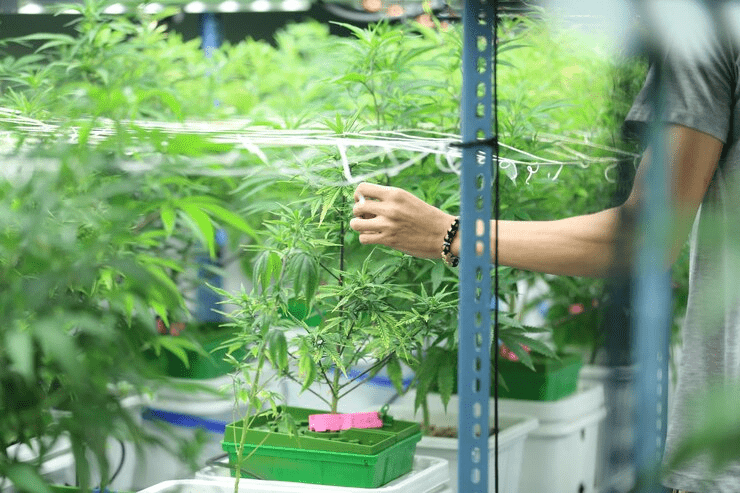Vertical farming has gained increasing attention as an innovative solution for maximizing space, especially in urban environments where land is limited. Among the various components of vertical farming systems, vertical grow racks are essential tools for increasing plant production while optimizing the use of space. These racks provide a structured way to grow plants vertically, allowing farmers to achieve high crop yields in a relatively small footprint. However, as with any agricultural technology, vertical grow racks present several challenges that growers must consider when implementing them into their operations.
This article will discuss the main challenges of using vertical grow racks, explore the associated complexities of integrating a mobile shelving system, and consider the pros and cons of mobile racking in vertical farming. Additionally, we will delve into the specifics of a vertical grow system, focusing on how these systems interact with one another to affect overall efficiency and sustainability.
1. Limited Space for Large Plants
While vertical grow racks allow for the growth of numerous plants in confined spaces, they may not be suitable for larger crops. For instance, plants that require deep root systems, such as certain varieties of tomatoes or cucumbers, may not thrive in vertical systems without significant modification. The vertical height and the structure of mobile racking may restrict the growth potential of these plants. Even with adjustable racks, there is a limitation to how much vertical space is practical for large, sprawling crops.
Solution:
For larger crops, growers can either supplement their vertical racks with horizontal growing areas or implement a hybrid system that includes both vertical and horizontal growing spaces. Additionally, there are vertical grow system designs that include adjustable shelving or height control features, making it easier to accommodate larger plants.
2. Light Distribution and Coverage
One of the fundamental challenges with vertical grow racks is ensuring that every plant receives adequate light. In traditional horizontal growing, light coverage is more straightforward, with the sun or grow lights illuminating plants evenly across the surface. However, in a vertical grow system, light distribution becomes uneven, especially if the rack’s structure blocks light from reaching lower plants.
Solution:
To mitigate this issue, mobile shelving systems can be designed with rotating or adjustable shelves, allowing light to reach plants on all levels. Additionally, implementing an efficient lighting system, such as LED grow lights, can provide more uniform light coverage. These lights are energy-efficient and can be tailored to the specific needs of plants, minimizing the impact of uneven light distribution.
3. Watering and Irrigation System Complexity
In a vertical setup, the watering and irrigation system must be carefully designed to ensure that each plant receives sufficient moisture. Unlike horizontal farming, where water can be distributed evenly across a flat surface, vertical grow racks pose a challenge in terms of water flow. Water may not always reach the plants at the top or bottom, leading to dry patches or waterlogged areas.
Solution:
To address this challenge, mobile racking systems often incorporate automated irrigation solutions. Drip irrigation systems, misting systems, or hydroponic solutions, such as those used in vertical grow systems, can ensure consistent watering throughout the growing cycle. Proper planning of the irrigation network within the racking system will also minimize water wastage and ensure optimal plant health.
4. Managing Plant Growth and Health
In a vertical farming setup, managing plant health can be more complex compared to traditional farming methods. The confined space of vertical grow racks can increase the likelihood of plant disease and pest outbreaks, as the plants are in close proximity to each other. Moreover, the restricted airflow can lead to higher humidity, creating an ideal environment for mold and fungal growth.
Solution:
A robust vertical grow system design should integrate adequate air circulation, which can be achieved by installing fans or other ventilation systems. Additionally, using pest management strategies, such as integrated pest management (IPM), and monitoring environmental conditions using sensors can help reduce the risks of plant disease and pests. Implementing a regular cleaning and maintenance routine is crucial for maintaining a healthy growing environment.
5. High Initial Investment and Maintenance Costs
Setting up vertical grow racks requires a significant initial investment, especially if incorporating advanced mobile shelving systems or automated systems. These systems can be costly to purchase, install, and maintain. For instance, advanced mobile racking systems that incorporate movement or automated functions can add to the upfront costs. Furthermore, regular maintenance of the racks, irrigation systems, lighting, and sensors can increase ongoing operational expenses.
Solution:
While the initial cost can be high, the long-term benefits of increased crop yield and space efficiency often outweigh the investment. Many farmers find that, over time, the increased efficiency of vertical grow systems leads to lower operational costs and higher profits. Additionally, some growers opt for modular systems that can be expanded as the business grows, minimizing initial capital outlay.
6. Limited Customization for Certain Crops
Vertical grow racks are often designed with standard plant types and sizes in mind, which can limit the ability to customize the system for specific crops. For example, certain crops may require larger or smaller racks, different lighting, or unique spacing. Growers with specialized crop needs may find it difficult to adapt existing systems to fit their specific requirements.
Solution:
The solution to this challenge lies in developing more versatile and customizable mobile racking systems that can be adjusted to accommodate a wider variety of crops. Some vertical grow systems come with adjustable heights, spacing, and shelf configurations, allowing growers to tailor their setup to meet the specific needs of each plant variety.
7. Energy Consumption
Energy consumption is a significant concern when using vertical grow racks equipped with artificial lighting and irrigation systems. While these systems offer improved space efficiency, they may require additional energy to maintain optimal growing conditions. The energy demands of lights, fans, and water pumps can increase operational costs, especially if the system is running 24/7.
Solution:
To address energy consumption, growers can opt for energy-efficient solutions, such as LED grow lights that use less electricity while still providing sufficient light for plant growth. Solar panels or other renewable energy sources can also be integrated into the system to offset energy costs. Additionally, energy-efficient irrigation systems can help reduce overall energy usage.
Conclusion
Using vertical grow racks can significantly increase crop production and make better use of limited space, but there are numerous challenges that come with this method. From ensuring proper light distribution and watering to managing plant health and addressing energy concerns, there are various factors that growers must carefully consider. With proper planning, design, and investment in suitable technologies like mobile shelving systems and mobile racking, these challenges can be mitigated. By understanding the complexities of vertical grow systems, growers can create more sustainable and efficient farming operations that maximize both space and yield.













